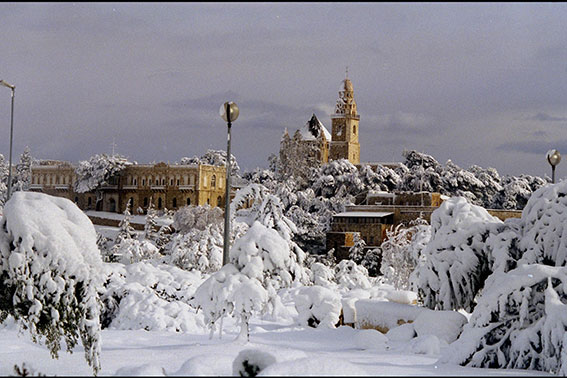Jerusalem snowstorm - an analysis
Jay Levinson analyses the emergency response to recent unprecedented snowfall in Jerusalem.

Photo courtesy Government Press Service (GPO) via Flickr
For the young, the snowstorm that hit parts of Israel in early December was a fun fiesta with the opportunity to populate neighbourhoods with snowmen. For emergency planners, the storm was no less than a major nightmare, as responders fought the elements to extricate people and save lives.
Police Chief Yochanan Danino rebuked the public for casting blame on responders, who were trying their best to give service. He spoke not only in the name of the Israel Police, but for all of those who were giving their maximum under extremely trying conditions. Even the Prime Minister appealed to the public to appreciate that priority was being given to preserving human life.
In Jerusalem and the surrounding area immobilised cars blocked highways, and their drivers and passengers had to be extricated. Food could not be delivered in light of the weather conditions. Electrical lines were brought down, and workers could not access them owing to road conditions. The sick could not be brought in for treatment. There were often intolerable delays.
The coastal areas had different problems, but their situation was little better. With warmer temperatures that precluded snow, torrential rains caused flooding and electrical problems. Roads were closed, and in many cases public transportation came to a standstill. Hail was the cause of numerous traffic accidents.
There was definitely a breakdown in emergency response. On the one hand it is absolutely out of place to criticize those who spared no effort under very difficult conditions, but on the other hand reality cannot be denied. There was a problem, a very serious problem.
What went wrong? It lies in planning, not execution. It is a challenge to correct for the future, not to condemn for the past.
There were complaints. Most government services are geared towards the expectations of citizens. Bureaucracy is slow to move, and in this vein its ability to detect attitude changes is quite limited. Dissatisfaction comes when there is a change in expectations but not in service, and service is dictated in good measure by planning. In all justice to government, sometimes those changes come concurrently with an event, hence there is a gap between execution and expectation.
Can government give satisfactory service in times of disaster? The February 1969 "Lindsay Snowstorm" in New York is a classic example of changed expectations that essentially ruined the political career of Mayor Lindsay, even though in the aftermath of the storm correct measures were undertaken to meet the new expectations. Planning was changed.
Limiting factors, of course, are budgetary constraints, time needed for change, and the realism of expectations.
If these days of stormy weather will have any positive benefit, it is that they should be flashing a red light to the way the State of Israel has planned for all sorts of disasters - not only weather, but also earthquake, and an enemy military offensive.
Currently there is an innovative salad of preparations that lack unified command with a National Emergency Authority, run under the umbrella of the Ministry of Defence, that is virtually powerless as it oversees operations. Its focus is reaction to a war situation, and although its mandate has been broadened to include peacetime scenarios, the mindset has not really changed.
The IDF and the Israel Police evacuated people to makeshift temporary shelters. As part of Ministry of Interior emergency planning, there is provision for shelters that provide beds and food, but the concept is entrenched in wartime thinking, where people will be moved from their destroyed homes to local facilities. In this emergency many people were not local. Mattresses in the International Convention Centre in Jerusalem were in short supply, and there were continued complaints of lack of food. The fault does not lie with the Jerusalem Municipality, which in this case is the operative arm of planning. It rests with the deficiencies of the national planning itself.
The next test will be coping with melting snow and mountain water run-off, as they both pose the potential of flooding.
The IDF gave strong support to emergency operations, providing resources from heavy vehicles assisting in road clearance, to providing fuel and food to stranded towns and settlements. In this case the army had the resources, but one wonders what would happen in wartime, when enemy missiles wreak havoc, and the IDF has to expend its resources on thwarting the enemy.
As the saying goes: "The wise man does not learn from his mistakes. He learns from the mistakes of others, so that he does not make mistakes." Quick examples of past events can be found in the response to the Loma Prieta (San Francisco Bay) earthquake in October 1989. Disabled cars and destroyed buildings blocked the passage of emergency vehicles. Roads were destroyed (and bridges fell). There were electrical outages, and live wires were exposed.
The Emergency Authority was established in 2007, but proof of its ineffective action can be seen in the repeated warnings by the State Comptroller, as recently as in an extensive report in 2011, that Israel is unprepared for a major disaster. In the wake of the current weather emergency there will be another comptroller's report, and there are calls for a Knesset investigation as well, but unless there is a change in basic attitude and priorities, the reports will add little except as new archival material.
To all who gave dedicated service during this emergency, good job! Now, however, it is time to give a serious rethink to plans for potential emergencies in the future.
Jay Levinson is a Member of CRJ's Editorial Advisory Panel
Jay Levinson, 23/12/2013